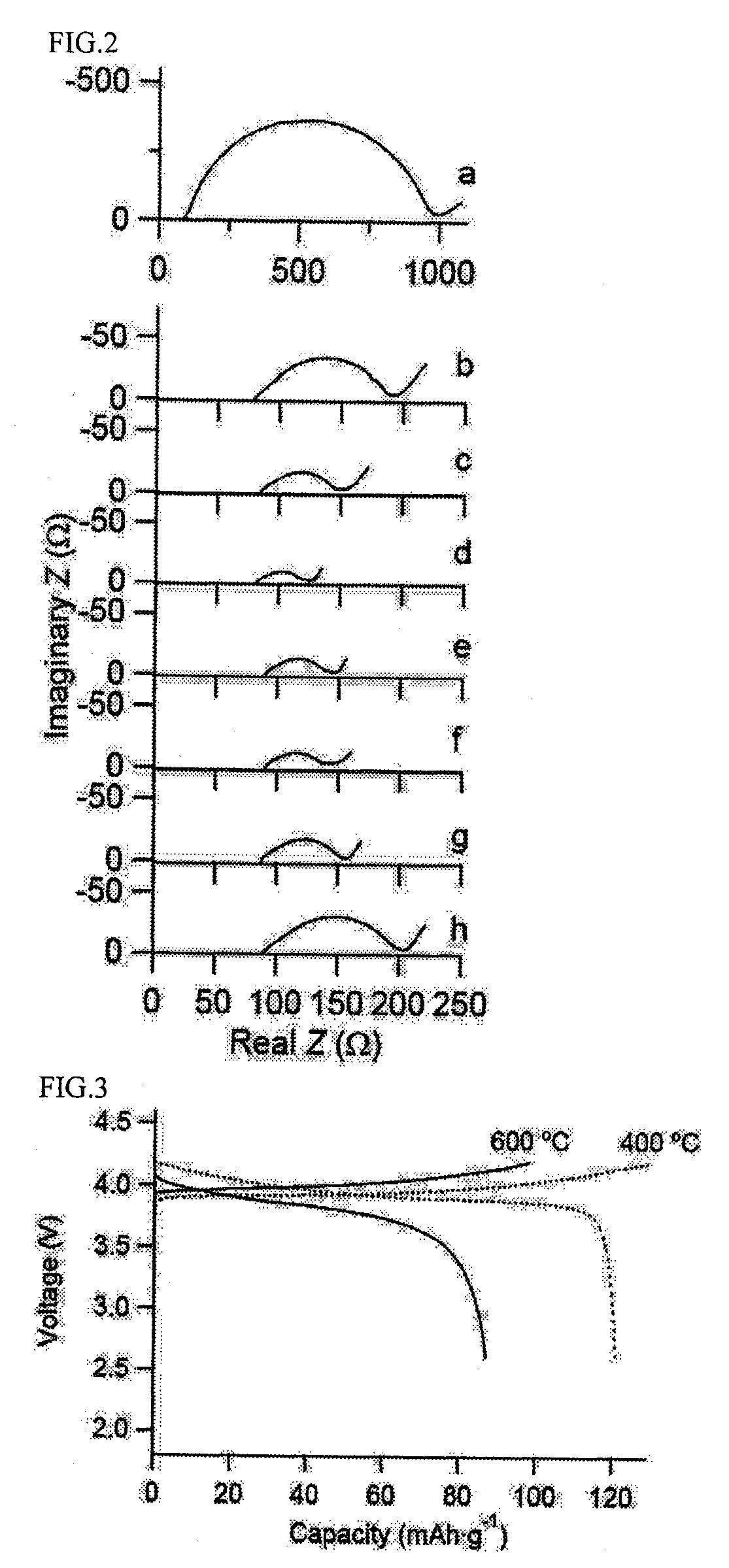All-solid lithium battery
a lithium battery, all-solid technology, applied in the field of lithium batteries, can solve the problems of oxidation or reduction, most of self-discharge, decrease in capacity, etc., and achieve the effect of superior output performance and particularly problematic formation of high-resistance layers
- Summary
- Abstract
- Description
- Claims
- Application Information
AI Technical Summary
Benefits of technology
Problems solved by technology
Method used
Image
Examples
example 1
[0050]In this Example, an all-solid lithium battery was produced by using LiCoO2 as the positive electrode active material, Li4 / 3Ti5 / 3O4 as the lithium ion-conducting oxide, and Li2S—GeS2—P2S5 as the sulfide lithium ion-conducting solid electrolyte.
[0051]LiCoO2 having an average particle diameter of 10 μm was used. LiCoO2 was synthesized by firing a mixture of starting materials, Li2CO3 and CO3O4, at a molar ratio Li / Co=1 / 1 at 900° C. for 8 hours. A Li4 / 3Ti5 / 3O4 layer, i.e., lithium ion-conducting oxide layer, was formed on the surface of a LiCoO2 particle by the following process.
[0052]The Li4 / 3Ti5 / 3O4 layer was formed by hydrolysis of the alkoxide solution containing lithium and titanium on the LiCoO2 particle surfaces. First, metallic lithium was dissolved in absolute ethanol to prepare an ethanol solution of lithium ethoxide. To the solution, titanium tetraisopropoxide (Ti(i-OC3H7)4) was added so that the molar ratio Li / Ti was 4 / 5, and the resulting mixture was diluted with abso...
example 2
[0064]In this example, an all-solid lithium battery was produced by using LiMn2O4 as the positive electrode active material, LiTi2(PO4)3 as the lithium ion-conducting oxide, and a Li3PO4—Li2S—SiS2 glass as the sulfide lithium ion-conducting solid electrolyte. LiMn2O4 was synthesized by firing a mixture of lithium carbonate and manganese oxide having a molar ratio Li / Mn of 1 / 2 at 800° C. for 8 hours.
[0065]Metallic lithium was dissolved in absolute ethanol to prepare an alkoxide solution of lithium. Diphosphorus pentaoxide was dissolved in absolute ethanol to prepare an alkoxide solution of phosphorus. Titanium tetraisopropoxide (Ti(i-OC3H7)4) and then absolute ethanol were added to these alkoxide solutions to prepare a coating solution having a solid content (LiTi2(PO4)3) of 39 mg per liter of the coating solution.
[0066]To the LiMn2O4 powder (100 mg) synthesized above, 42 mL of the coating solution was added, and the alcohol was evaporated under stirring. Subsequently, the residue wa...
example 3
[0071]In this Example, a LiCoO2 thin film was used as the positive electrode active material, and a Li4 / 3Ti5 / 3O4 thin film was formed as the lithium ion-conducting oxide on the surface of the LiCoO2 film. As in Example 1, Li2S—GeS2—P2S5 was used as the sulfide lithium ion-conducting solid electrolyte.
[0072]The LiCoO2 thin film was formed by pulsed laser deposition. The deposition source used was a pellet prepared by mixing Li2CO3 and CO3O4 such that the composition was Li1.3CoO2, firing the resulting mixture at 900° C., and sintering the mixture. Using this pellet as the deposition source, a LiCoO2 thin film was deposited to a thickness of about 150 nm on a platinum plate in an oxygen atmosphere.
[0073]A Li4 / 3Ti5 / 3O4 thin film was then formed on the LiCoO2 thin film fabricated as such. In forming the thin film, pulsed laser deposition was employed as with LiCoO2. First, Li2CO3 powder and TiO2 powder were mixed such that the molar ratio Li / Ti was 1.03, and the resulting mixture was fi...
PUM
| Property | Measurement | Unit |
|---|---|---|
| Temperature | aaaaa | aaaaa |
| Thickness | aaaaa | aaaaa |
| Thickness | aaaaa | aaaaa |
Abstract
Description
Claims
Application Information
 Login to View More
Login to View More - R&D
- Intellectual Property
- Life Sciences
- Materials
- Tech Scout
- Unparalleled Data Quality
- Higher Quality Content
- 60% Fewer Hallucinations
Browse by: Latest US Patents, China's latest patents, Technical Efficacy Thesaurus, Application Domain, Technology Topic, Popular Technical Reports.
© 2025 PatSnap. All rights reserved.Legal|Privacy policy|Modern Slavery Act Transparency Statement|Sitemap|About US| Contact US: help@patsnap.com



